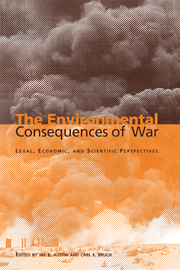Book contents
- Frontmatter
- Contents
- List of illustrations
- List of tables
- List of contributors
- Acknowledgements
- Foreword by Klaus Toepfer
- Introduction
- Part I General principles
- Part II The legal framework
- Part III Assessing the impacts – scientific methods and issues
- Part IV Valuing the impacts – economic methods and issues
- Part V Prospects for the future
- Introduction
- 22 Protecting specially important areas during international armed conflict: a critique of the IUCN Draft Convention on the Prohibition of Hostile Military Activities in Protected Areas
- 23 The Chemical Weapons Convention: a verification and enforcement model for determining legal responsibility for environmental harm caused by war
- 24 International legal mechanisms for determining liability for environmental damage under international humanitarian law
- 25 Waging war against the world: the need to move from war crimes to environmental crimes
- Epilogue
- Index
Introduction
Published online by Cambridge University Press: 04 August 2010
- Frontmatter
- Contents
- List of illustrations
- List of tables
- List of contributors
- Acknowledgements
- Foreword by Klaus Toepfer
- Introduction
- Part I General principles
- Part II The legal framework
- Part III Assessing the impacts – scientific methods and issues
- Part IV Valuing the impacts – economic methods and issues
- Part V Prospects for the future
- Introduction
- 22 Protecting specially important areas during international armed conflict: a critique of the IUCN Draft Convention on the Prohibition of Hostile Military Activities in Protected Areas
- 23 The Chemical Weapons Convention: a verification and enforcement model for determining legal responsibility for environmental harm caused by war
- 24 International legal mechanisms for determining liability for environmental damage under international humanitarian law
- 25 Waging war against the world: the need to move from war crimes to environmental crimes
- Epilogue
- Index
Summary
INTRODUCTION
As will be discussed in detail in the Epilogue to this volume, the 1999 Kosovo conflict showed the inadequacy of existing legal mechanisms for hearing and evaluating allegations of wartime environmental damage. Among other things, Yugoslavia's International Court of Justice lawsuit against the ten NATO countries alleged breaches of “the obligation not to cause considerable environmental damage,” “the obligation not to cause far-reaching health and environmental damage,” and “the obligation not to use prohibited weapons.” Taken purely on their face, these charges-epitomized by the NATO bombing of the Pancevo petrochemical complex and the use of depleted uranium – could plausibly have triggered provisions of the Geneva Conventions, Protocol I, and customary international law, all of which were cited in the petition. Yet they suffered the same fate as Yugoslavia's other assertions of legal violations: the ICJ, limited by its consent-based system of jurisdiction, declined to address the merits of the case.
The question remains how, even in the wake of justifiable outrage about Serbia's own clear violations of law, the consequences of NATO actions also might be examined, judged, and if necessary redressed. At the same time that the International Criminal Tribunal for the Former Yugoslavia handed down its historic indictment of President Slobodan Milos̃ević, a coalition of Greek, Canadian, and US lawyers was petitioning the Tribunal to investigate the legality of NATO's bombing campaign and to indict NATO leaders, including President Bill Clinton and Prime Minister Tony Blair. Once the health and environmental impacts of the Pancevo bombing became known, Serb lawyers considered the possibility of filing civil damage suits against the United States.
- Type
- Chapter
- Information
- The Environmental Consequences of WarLegal, Economic, and Scientific Perspectives, pp. 559 - 566Publisher: Cambridge University PressPrint publication year: 2000
- 1
- Cited by



